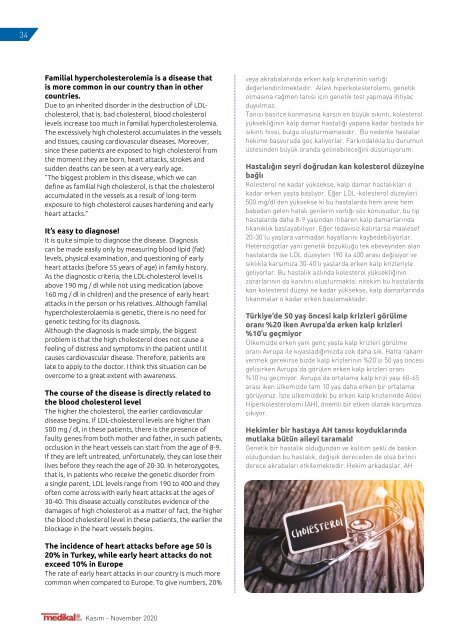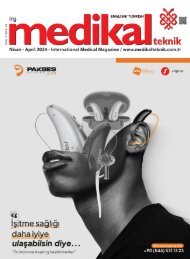Create successful ePaper yourself
Turn your PDF publications into a flip-book with our unique Google optimized e-Paper software.
34<br />
Familial hypercholesterolemia is a disease that<br />
is more common in our country than in other<br />
countries.<br />
Due to an inherited disorder in the destruction of LDLcholesterol,<br />
that is, bad cholesterol, blood cholesterol<br />
levels increase too much in familial hypercholesterolemia.<br />
The excessively high cholesterol accumulates in the vessels<br />
and tissues, causing cardiovascular diseases. Moreover,<br />
since these patients are exposed to high cholesterol from<br />
the moment they are born, heart attacks, strokes and<br />
sudden deaths can be seen at a very early age.<br />
“The biggest problem in this disease, which we can<br />
define as familial high cholesterol, is that the cholesterol<br />
accumulated in the vessels as a result of long-term<br />
exposure to high cholesterol causes hardening and early<br />
heart attacks.”<br />
It’s easy to diagnose!<br />
It is quite simple to diagnose the disease. Diagnosis<br />
can be made easily only by measuring blood lipid (fat)<br />
levels, physical examination, and questioning of early<br />
heart attacks (before 55 years of age) in family history.<br />
As the diagnostic criteria, the LDL-cholesterol level is<br />
above 190 mg / dl while not using medication (above<br />
160 mg / dl in children) and the presence of early heart<br />
attacks in the person or his relatives. Although familial<br />
hypercholesterolaemia is genetic, there is no need for<br />
genetic testing for its diagnosis.<br />
Although the diagnosis is made simply, the biggest<br />
problem is that the high cholesterol does not cause a<br />
feeling of distress and symptoms in the patient until it<br />
causes cardiovascular disease. Therefore, patients are<br />
late to apply to the doctor. I think this situation can be<br />
overcome to a great extent with awareness.<br />
The course of the disease is directly related to<br />
the blood cholesterol level<br />
The higher the cholesterol, the earlier cardiovascular<br />
disease begins. If LDL-cholesterol levels are higher than<br />
500 mg / dl, in these patients, there is the presence of<br />
faulty genes from both mother and father, in such patients,<br />
occlusion in the heart vessels can start from the age of 8-9.<br />
If they are left untreated, unfortunately, they can lose their<br />
lives before they reach the age of 20-30. In heterozygotes,<br />
that is, in patients who receive the genetic disorder from<br />
a single parent, LDL levels range from 190 to 400 and they<br />
often come across with early heart attacks at the ages of<br />
30-40. This disease actually constitutes evidence of the<br />
damages of high cholesterol: as a matter of fact, the higher<br />
the blood cholesterol level in these patients, the earlier the<br />
blockage in the heart vessels begins.<br />
veya akrabalarında erken kalp krizlerinin varlığı<br />
değerlendirilmektedir. Ailevi hiperkolesterolemi, genetik<br />
olmasına rağmen tanısı için genetik test yapmaya ihtiyaç<br />
duyulmaz.<br />
Tanısı basitçe konmasına karşın en büyük sıkıntı, kolesterol<br />
yüksekliğinin kalp damar hastalığı yapana kadar hastada bir<br />
sıkıntı hissi, bulgu oluşturmamasıdır. Bu nedenle hastalar<br />
hekime başvuruda geç kalıyorlar. Farkındalıkla bu durumun<br />
üstesinden büyük oranda gelinebileceğini düşünüyorum.<br />
Hastalığın seyri doğrudan kan kolesterol düzeyine<br />
bağlı<br />
Kolesterol ne kadar yüksekse, kalp damar hastalıkları o<br />
kadar erken yaşta başlıyor. Eğer LDL-kolesterol düzeyleri<br />
500 mg/dl’den yüksekse ki bu hastalarda hem anne hem<br />
babadan gelen hatalı genlerin varlığı söz konusudur, bu tip<br />
hastalarda daha 8-9 yaşından itibaren kalp damarlarında<br />
tıkanıklık başlayabiliyor. Eğer tedavisiz kalırlarsa maalesef<br />
20-30’lu yaşlara varmadan hayatlarını kaybedebiliyorlar.<br />
Heterozigotlar yani genetik bozukluğu tek ebeveynden alan<br />
hastalarda ise LDL düzeyleri 190 ila 400 arası değişiyor ve<br />
sıklıkla karşımıza 30-40’lı yaşlarda erken kalp krizleriyle<br />
geliyorlar. Bu hastalık aslında kolesterol yüksekliğinin<br />
zararlarının da kanıtını oluşturmakta: nitekim bu hastalarda<br />
kan kolesterol düzeyi ne kadar yüksekse, kalp damarlarında<br />
tıkanmalar o kadar erken başlamaktadır.<br />
Türkiye’de 50 yaş öncesi kalp krizleri görülme<br />
oranı %20 iken Avrupa’da erken kalp krizleri<br />
%10’u geçmiyor<br />
Ülkemizde erken yani genç yaşta kalp krizleri görülme<br />
oranı Avrupa ile kıyasladığımızda çok daha sık. Hatta rakam<br />
vermek gerekirse bizde kalp krizlerinin %20’si 50 yaş öncesi<br />
gelişirken Avrupa’da görülen erken kalp krizleri oranı<br />
%10’nu geçmiyor. Avrupa’da ortalama kalp krizi yaşı 60-65<br />
arası iken ülkemizde tam 10 yaş daha erken bir ortalama<br />
görüyoruz. İşte ülkemizdeki bu erken kalp krizlerinde Ailevi<br />
Hiperkolesterolemi (AH), önemli bir etken olarak karşımıza<br />
çıkıyor.<br />
Hekimler bir hastaya AH tanısı koyduklarında<br />
mutlaka bütün aileyi taramalı!<br />
Genetik bir hastalık olduğundan ve kalıtım şekli de baskın<br />
olduğundan bu hastalık, değişik dereceden de olsa birinci<br />
derece akrabaları etkilemektedir. Hekim arkadaşlar, AH<br />
The incidence of heart attacks before age 50 is<br />
20% in Turkey, while early heart attacks do not<br />
exceed 10% in Europe<br />
The rate of early heart attacks in our country is much more<br />
common when compared to Europe. To give numbers, 20%<br />
Kasım - November <strong>2020</strong>

















